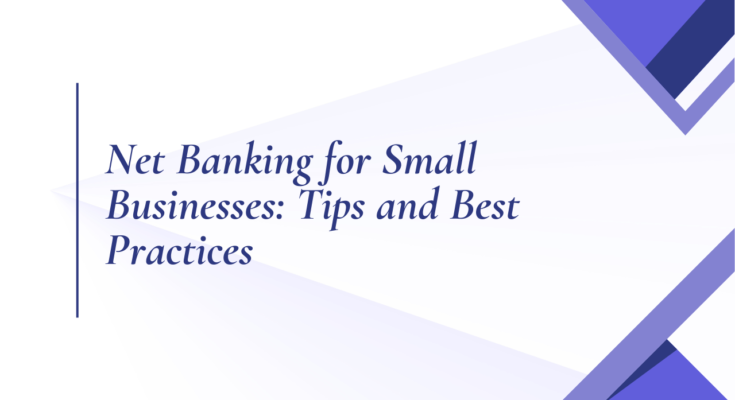In today’s fast-paced digital environment, small businesses are increasingly turning to online banking as a strong tool for streamlining financial operations. But navigating the world of internet banking may be difficult, especially if you are new to it. Whether you want to manage cash flow more effectively, make transactions easier, or improve your company’s financial security, net banking provides a variety of benefits tailored to your specific needs.
In this article, we’ll explore essential tips and best practices for leveraging net banking to optimize your small business’s financial management. From setting up your account and automating payments to ensuring robust security measures, we’ll cover everything you need to know to make the most of this convenient and efficient banking solution.
So, buckle up and get ready to take your business finances to the next level with these practical and actionable insights.
Contents
- 1 Setting Up Business Accounts: How to Establish Net Banking for Your Business
- 2 Managing Cash Flow: Using Net Banking to Streamline Cash Flow Management
- 3 Payment Processing: Efficient Ways to Handle Business Transactions Online
- 4 Security Measures: Protecting Your Business from Online Fraud
- 5 Conclusion
Setting Up Business Accounts: How to Establish Net Banking for Your Business
When you’re ready to take your business finances online, setting up net banking is a must. Not only does it make managing money easier, but it also adds a layer of convenience that you simply can’t get with traditional banking. Whether you’re new to business banking or just looking to switch things up, this guide will walk you through the steps to get started with net banking for your business.
Choose the Right Bank for Your Business
Before getting into the specifics of setting up net banking, you must first select the best bank for your company needs. Every bank has distinct features, so it’s critical to pick one that fits your company needs. Do you require robust security features, or do you prefer a user-friendly interface?
Consider what is most important to your business. Consider fees, as some banks charge for specific sorts of transactions or services. Once you’ve narrowed down your selections, contact the banks and inquire about their business account packages and online banking services.
Gather the Necessary Documentation:
Now that you’ve chosen your bank, it’s time to gather all the paperwork you’ll need to open a business account. Typically, banks require proof of your business identity, such as your business registration certificate, tax identification number, and identification documents for all account signatories. It might seem like a lot, but having everything in order will make the process much smoother.
If you’re unsure about any of the required documents, don’t hesitate to contact the bank. They’ll guide you through what’s needed and help ensure you don’t miss a step.
Set Up and Customize Your Net Banking Account
With your business account established, you’re almost ready to go digital. Most banks provide an online registration process that takes only a few minutes to complete. You’ll establish a username and password, set up security questions, and then you’re in! Once you’ve logged in, spend some time customizing your account settings.
This might include setting up alerts for transactions, linking multiple business accounts, or even integrating your net banking with accounting software. The more you tailor it to your business needs, the more efficient your financial management will become.
You may set up your business net banking account in a few simple steps. Remember, this is a tool to help you manage your finances, so educate yourself with all of its functions. As you traverse the world of business banking, you’ll see that net banking not only streamlines transactions but also provides you more control over your finances.

Managing Cash Flow: Using Net Banking to Streamline Cash Flow Management
When it comes to running a business, cash flow is like the lifeblood that keeps everything moving. But managing it can sometimes feel like juggling too many balls at once. Luckily, net banking can be your secret weapon to keep that cash flowing smoothly and, more importantly, stress-free. Let’s dive into how you can use net banking to make cash flow management a breeze.
Keep an Eye on Incoming and Outgoing Funds:
The basic rule of cash flow management is to understand exactly what’s coming in and going out. Net banking allows you to monitor your account balances and transaction history at any time and from any location. No more waiting for monthly statements or going to the bank; simply log in and obtain an instant view of your finances.
You can even set up real-time alerts for incoming payments, so you’ll always know when money hits your account. This helps you stay on top of your cash flow and ensures you’re never caught off guard.
Automate Payments to Keep Things Running Smoothly:
One of the most difficult cash flow issues is managing payments, whether they be for suppliers, employees, or even just the monthly expenses. Net banking enables you to automate these payments, allowing you to focus on running your business rather than worrying about deadlines.
Set up recurring payments for regular expenses, and you can rest easy knowing they’ll be taken care of on time. Plus, with automatic payments, you reduce the risk of late fees and missed payments, which can disrupt your cash flow.
Make Transfers and Payments in a Snap:
Need to transfer funds between accounts or pay a vendor quickly? Net banking makes it exceedingly simple. You can transfer funds with a few clicks, whether you’re in your office or on the go. This fast access to your money allows you to respond to cash flow issues right away, whether it’s covering an unforeseen bill or capitalizing on a business opportunity.
Managing cash flow does not have to be an ongoing issue. You may streamline the entire process by utilizing net banking tools and capabilities, freeing up more time to focus on building your business. So go ahead, take control of your cash flow, and allow net banking make financial management a little easier—and maybe even more enjoyable!
Payment Processing: Efficient Ways to Handle Business Transactions Online
Efficient payment processing is crucial for any organization operating in the modern digital environment. Whether you’re selling items, services, or both, managing transactions smoothly may make or break client happiness.
The good news is that there are numerous ways to handle online payments that are quick, safe, and, most importantly, simple. Let’s look at some effective ways for streamlining your business transactions online.
Choose the Right Payment Gateway:
The first step in setting up efficient online payment processing is to choose the appropriate payment gateway. This is the service that manages your transactions and connects your company to banks or credit card providers. When selecting a payment gateway, you should evaluate transaction fees, ease of integration, and payment methods accepted.
Whether it’s credit cards, digital wallets, or even cryptocurrency, make sure your payment gateway supports the options your customers prefer. A smooth checkout process can increase conversions and keep your customers coming back for more.
Automate Invoicing for Faster Payments:
It can be somewhat stressful to chase down money, but automating your invoicing will help. Many online payment platforms include automated invoicing services, which allow you to automatically send bills when a product is purchased or a service is finished.
You can also set up reminders for overdue payments, helping you get paid faster without lifting a finger. Automated invoicing not only saves time but also ensures accuracy, reducing the risk of errors that can delay payments.
Secure Your Transactions to Build Trust:
When it comes to online payments, customers are most concerned about security. If customers do not believe their information is secure, they are likely to leave the transaction. Invest in strong security measures for online payment processing to provide your clients peace of mind.
This includes using SSL encryption, two-factor authentication, and adhering to PCI DSS regulations. The more secure your payment method, the more likely customers are to complete their purchases and return for future transactions.
Online business transactions do not have to be hard or stressful. By selecting the correct payment gateway, automating invoicing, and safeguarding your transactions, you can make the entire process easier for both you and your clients.
So, go ahead and implement these efficient payment processing strategies—you’ll be surprised at how much easier managing your business finances can become!
Security Measures: Protecting Your Business from Online Fraud
Online fraud is a persistent challenge to organizations of all kinds in the digital era. But don’t worry—there are numerous ways to defend your business and keep fraudsters at away. Implementing strong security measures can make all the difference in keeping your business and consumer information safe.
Let’s take a look at some practical measures you may take to protect your business from internet fraud.
Implement Strong Password Policies:
A strong password is your first line of defense against online fraud. Encourage everyone in your business to create complex passwords that are hard to guess. This means using a mix of letters, numbers, and symbols. You can also require password changes every few months to keep things extra secure.
If remembering multiple passwords seems daunting, consider using a password manager. This tool stores and encrypts passwords, making it easier for your team to access accounts securely without the hassle of remembering everything.
Also read: How to Maximize Rewards with Net Banking
Enable Two-Factor Authentication:
Two-factor authentication (2FA) adds an extra layer of security to your accounts, making it much harder for fraudsters to break in. With 2FA, even if someone gets hold of your password, they’ll still need a second form of verification, like a code sent to your phone.
Many online platforms offer 2FA as an option, so take advantage of it whenever you can. It’s a simple but effective way to protect your business from unauthorized access and potential fraud.
Monitor Transactions for Suspicious Activity:
Keeping an eye on your transactions is key to catching fraud before it becomes a bigger problem. Most banks and payment platforms offer transaction monitoring tools that alert you to suspicious activity, such as unusual spending patterns or transactions from unfamiliar locations.
Set up these alerts to stay informed and act quickly if something doesn’t look right. Regularly reviewing your account activity can help you spot fraud early and take action before it causes significant damage.
Online fraud is a serious issue, but with the proper security measures in place, you can safeguard your business and have peace of mind. By setting strong passwords, activating two-factor authentication, and monitoring transactions, you can build a safe environment that keeps fraudsters out and your business running smoothly.
So, take these steps today and enjoy the confidence that comes with knowing your business is well-protected!
Conclusion
Taking your business activities online can seem like a significant step, but with the appropriate tactics in place, it can be a simple and successful experience. From setting up your net banking to managing cash flow efficiently, processing payments effortlessly, and protecting your company from online fraud, each step is critical to establishing a solid financial base.
By selecting the correct banking tools, automating when possible, and remaining careful about security, you are not just managing your company’s finances, but also empowering it to survive in a digital environment. So, take these suggestions to heart and get the benefits of streamlined, secure, and smart banking for your business.




